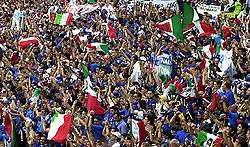Tifosi
Tifosi (pronounced [tiˈfoːzi; -oːsi]) is a group of supporters of a sports team, especially those that make up a tifo.

Etymology
In Italian, tifosi literally means 'those infected by typhus', in the sense of someone acting in a fevered manner.[1] Tifosi is used for a mixed gender or an all-male group; masculine singular is tifoso, feminine singular tifosa, feminine plural tifose.
Football
The word is mainly used to describe fans of clubs in football. Apart from the many local fan clubs in Italy whose main role is (for example) to provide a meeting place for fans and friends and organize away trips, since the late 1960s many Italian fans rely on organized stadium groups known as Ultras. The main goal is to choreograph fan support with flags, banners, coloured smoke screens, flares, drums, and chanting in unison. For most teams city rivalries, colours, coat of arms, symbols, and the overall iconography have roots in the Middle Ages and early Renaissance.
Formula One
It has become common to use the word Tifosi to refer to the supporters of Scuderia Ferrari in Formula One. Italian motor racing fans are well known for their love of Ferrari, though they have also been staunch supporters of other Italian cars such as Maserati, Lancia and Alfa Romeo.
The Tifosi provide Formula One with a sea of red filling the grandstands at the Italian Grand Prix. A similar sight could be observed in former years during the San Marino race which was held at the Autodromo Enzo e Dino Ferrari near the town of Imola, only 80 km (49.7 mi) east of the Ferrari factory in Maranello.
One of the most common Tifosi sights is the display of an enormous Ferrari flag in the grandstands during Formula One weekends at every race circuit, with especially large contingents showing up in Ferrari livery at home and nearby European tracks.
It has not been uncommon for the Tifosi in Italy to actually cheer for a non-Italian driver in a Ferrari passing an Italian driver in another make of car for the lead of a race. At the 1983 San Marino Grand Prix, the crowd at Imola cheered long and loud when Riccardo Patrese crashed his Brabham out of the lead of the race only 6 laps from home, handing Frenchman Patrick Tambay the win in his Ferrari. Patrese himself had only passed Tambay for the lead half a lap earlier.
The recent increase in their ranks can be directly traced to the rise of Michael Schumacher, who drove for Ferrari from 1996 to 2006, leading the team to the Constructors' Championship from 1999–2004.
One driver who never actually drove for the Prancing Horse, but will forever hold a special place in the hearts of the Tifosi is Frenchman Jean-Louis Schlesser. He drove for the Williams team at the 1988 Italian Grand Prix at Monza substituting for an ill Nigel Mansell. On lap 49 of the 51 lap race, Schlesser was unwittingly involved in the incident at the Variante del Rettifilo chicane that took out the leading McLaren-Honda of Ayrton Senna, fittingly handing Ferrari's Gerhard Berger and Michele Alboreto an emotional 1–2 Italian Grand Prix result only a month after the death of Enzo Ferrari. Berger's win handed McLaren their only loss of the 16-race 1988 season.[2]
Cycling
The word is commonly used to describe fans along the roadside at professional road cycling races in Italy such as Tirreno–Adriatico, Milan–San Remo, the Giro d'Italia, and the Giro di Lombardia.
Passionate supporters of Italian cycling teams & cyclists are called 'the tifosi'.
See also
- Curva
- Ultras
References
- Guttmann, Allen (2007). Sports: The First Five Millennia. University of Massachusetts Press. p. 192. ISBN 9781558496101. Retrieved 5 August 2016.
- Andrew Benson (8 September 2009). "Your classic Italian Grand Prix - Andrew Benson's blog". BBC. Retrieved 27 August 2013.